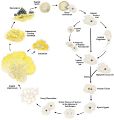(Steps) |
(text) |
||
| Line 9: | Line 9: | ||
https://knowledge.carolina.com/discipline/life-science/biology/the-slime-mold-physarum-polycephalum/ | https://knowledge.carolina.com/discipline/life-science/biology/the-slime-mold-physarum-polycephalum/ | ||
| Line 17: | Line 18: | ||
'''<big>Step 1: Preparing petri dishes:</big>''' | '''<big>Step 1: Preparing petri dishes:</big>''' | ||
<u>Materials:</u> Petri dishes, Erlenmeyer flask/pot, distilled water/tap water, powdered agar, scale | <u>Materials:</u> Petri dishes, Erlenmeyer flask/pot, distilled water/tap water, powdered agar, scale, spoon, aluminium foil | ||
The easiest gel to make is agar-agar-medium at a ratio of 1 to 100: | The easiest gel to make is agar-agar-medium at a ratio of 1 to 100: | ||
| Line 36: | Line 37: | ||
- Fill the needed amount of water either into a pot or the Erlenmeyer flask | - Fill the needed amount of water either into a pot or the Erlenmeyer flask | ||
- Weigh the needed amount of powdered agar (e.g. by using some | - Weigh the needed amount of powdered agar (e.g. by using some aluminium foil as a dish) | ||
- Stir the agar into the water | - Stir the agar into the water | ||
| Line 42: | Line 43: | ||
- Stir and heat the mixture until it's boiling (by using the stovetop or microwave) and take it off the heat before it boils over | - Stir and heat the mixture until it's boiling (by using the stovetop or microwave) and take it off the heat before it boils over | ||
- Pour the mixture into the petri dishes until they are max. halfway full and let them cool down until the medium has solidified | - Pour the mixture into the petri dishes until they are max. halfway full, close the lids and let them cool down until the medium has solidified | ||
'''<big>Step 2: Preparing food for the slime mold</big>''' | |||
Since Physarum is capable of ingesting material by phagocytosis, it needs "food" to grow, if it's starved, it will escape. | |||
A supply of oat flakes can be used as a source of food. | |||
While it is not absolutely necessary, the oat flakes can be sterilized to try to avoid possible contamination by using a pressure cooker: | |||
Materials: Glass jars with lids, cotton wadding, aluminium foil, water, pressure cooker | |||
- Prepare a jar with a lid by putting a hole into the lid and insert some cotton wadding tightly into the hole | |||
- Fill some oat flakes into the jars, close the lid and put aluminium foil over the lid (cover the lid completely) | |||
- Pour enough water into the pressure cooker, but not so much that the glasses are floating (follow manual for guidance), place the glasses inside | |||
- Close and lock the lid | |||
Revision as of 00:15, 26 August 2024
Species
Physarum Policephalum is an eucaryotic organism which belongs to the class of Myxogastria. It passes a life cycle of morphologic phases, with the phase in which the multinucleate cells form a plasmodium (thin film, with visible branches) often being used for study purposes. This slime mold can be found in cool, humid, darker places, for example on rotten wood in the forest.
Images taken from: https://www.ctvnews.ca/sci-tech/strange-yellow-slime-mold-can-remember-where-it-left-food-study-says-1.5326525
https://knowledge.carolina.com/discipline/life-science/biology/the-slime-mold-physarum-polycephalum/
Growing of Physarum
To be able to use the plasmodium for projects or study purposes, bigger cultures of Physarum have to be grown.
Step 1: Preparing petri dishes:
Materials: Petri dishes, Erlenmeyer flask/pot, distilled water/tap water, powdered agar, scale, spoon, aluminium foil
The easiest gel to make is agar-agar-medium at a ratio of 1 to 100:
| Component | Quantity | Custom Quantity |
|---|---|---|
| water | 100 ml | x |
| agar agar | 1 g | x |
- Fill the needed amount of water either into a pot or the Erlenmeyer flask
- Weigh the needed amount of powdered agar (e.g. by using some aluminium foil as a dish)
- Stir the agar into the water
- Stir and heat the mixture until it's boiling (by using the stovetop or microwave) and take it off the heat before it boils over
- Pour the mixture into the petri dishes until they are max. halfway full, close the lids and let them cool down until the medium has solidified
Step 2: Preparing food for the slime mold
Since Physarum is capable of ingesting material by phagocytosis, it needs "food" to grow, if it's starved, it will escape.
A supply of oat flakes can be used as a source of food.
While it is not absolutely necessary, the oat flakes can be sterilized to try to avoid possible contamination by using a pressure cooker:
Materials: Glass jars with lids, cotton wadding, aluminium foil, water, pressure cooker
- Prepare a jar with a lid by putting a hole into the lid and insert some cotton wadding tightly into the hole
- Fill some oat flakes into the jars, close the lid and put aluminium foil over the lid (cover the lid completely)
- Pour enough water into the pressure cooker, but not so much that the glasses are floating (follow manual for guidance), place the glasses inside
- Close and lock the lid
Step 3: Starting a new culture
There are two ways for starting a new culture of Physarum:
1) Using a part of an already existing culture:
- If there is already a culture available, take an oat flake with slime mold on top of it and place it in the prepared petri dish (or multiple oat flakes)
- Place new oat flakes

